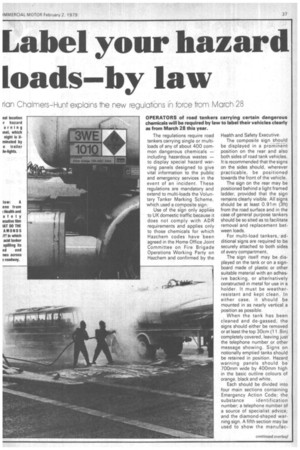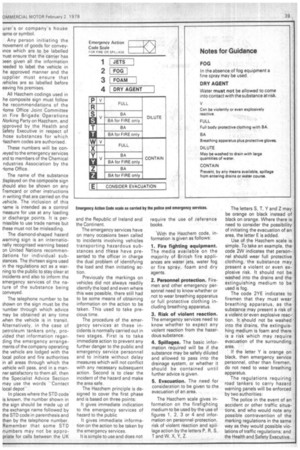Label your hazard loads by law
Page 39

Page 41

If you've noticed an error in this article please click here to report it so we can fix it.
rian Chalmers-Hunt explains the new regulations in force from March 28
OPERATORS of road tankers carrying certain dangerous chemicals will be required by law to label their vehicles clearly as from March 28 this year.
The regulations require road tankers carrying single or multiloads of any of about 400 common dangerous chemicals — including hazardous wastes — to display special hazard warning panels designed to give vital information to the public and emergency services in the event of an incident. These regulations are mandatory and extend to multi-loads the Voluntary Tanker Marking Scheme, which used a composite sign: Use of the sign only applies to UK domestic traffic because it does not comply with ADR requirements and applies only to those chemicals for which Hazchem codes have been agreed in the Home Office Joint Committee on Fire Brigade Operations Working Party on Hazchem and confirmed by the Health and Safety Executive.
The composite sign .should be displayed in a prominent position on the rear and also both sides of road tank vehicles. It is recommended that the signs on the sides should, wherever practicable, be positioned towards the front of the vehicle.
The sign on the rear may be positioned behind a light framed ladder, provided that the sign remains clearly visible. All signs should be at least 0.91m (3ft) from the road surface and in the case of general purpose tankers should be so sited as to facilitate removal and replacement between loads.
For multi-load tankers, additional signs are required to be securely attached to both sides of every compartment.
The sign itself may be displayed on the tank or on a signboard made of plastic or other suitable material with an adhesive backing. or alternatively constructed in metal for use in a holder. It must be weather resistant and kept clean. In either case, it should be mounted in as nearly vertical a position as possible.
When the tank has been cleaned and de-gassed, the signs should either be removed or at least the top 30em (11.8in) completely covered, leaving just' the telephone number or other message showing. Signs on notionally emptied tanks should be retained in position. Hazard warning panels should be 700mm wide by 400mm high in the basic outline colours of orange, black and white.
Each should be divided into four main sections containing Emergency Action Code; the substance identification number: a telephone number of a source of specialist advice; and the diamond-shaped warning sign. A fifth section may be used to show the manufac urer's or company's house lame or symbol.
Any person initiating the novement of goods for conveymce which are to be labelled nust ensure that the carrier has )een given all the information -ieeded to label the vehicle in he approved manner and the iupplier must ensure that tehicles are so labelled before eaving his premises.
All Hazchem codings used in he composite sign must follow he recommendations of the -tome Office Joint Committee m Fire Brigade Operations Norking Party on Hazchem, and )pproved by the Health and 3afety Executive in respect of hose substances for which -iazchem codes are authorised.
These numbers will be con/eyed to the emergency services md to members of the Chemical ndustries Association by the -lome Office.
The name of the substance displayed an the composite sign should also be shown on any Tremcard or other instructions
n writing that are carried on the vehicle. The inclusion of this lame is intended as a control measure for use at any loading Dr discharge points. It is permissible to use trade names but these must not be misleading.
The diamond-shaped hazard vvarning sign is an internationally recognised warning based Dn United Nations recommendations for individual substances. The thirteen signs used In the regulations act as a warning to the public to stay clear at incidents and also to inform the emergency services of the nature of the substance being conveyed.
The telephone number to be shown on the sign must be the lumber through which advice -nay be obtained at any time Nhen the vehicle is in transit. Alternatively, in the case of petroleum tankers only, provided that information regarding the emergency arrangements of the company operating the vehicle are lodged with the local police and fire authorities in all areas through which the vehicle will pass, and in a manner satisfactory to them all, then the Specialist Advice Section may use the words "Contact local depot".
In places where the STD code is known, the number shown in the sign should be made up of the exchange name followed by the STD code in parenthesis and then by the telephone number. Remember that some STD numbers may not be appropriate for calls between the UK and the Republic of Ireland and the Continent.
The emergency services have on many occasions been called to incidents involving vehicles transporting hazardous substances and these have presented to the officer in charge the dual problem of identifying the load and then initiating action.
Previously the markings on vehicles did not always readily identify the load and even where this was possible, there still had to be some means of obtaining information on the action to be taken. This used to take precious time.
The procedure of the emergency services at these incidents is normally carried out in two stages. First is to take immediate action to prevent any further danger to the public and emergency service personnel and to initiate without delay measures which will not conflict with any necessary subsequent action. Second is to clear the incident of the hazard and make the area safe.
The Hazchem principle is designed to cover the first phase and is based on three points: It gives immediate indication to the emergency services of hazard to the public It gives immediate information on the action to be taken by the emergency services.
It is simple to use and does not require the use of reference books.
With the Hazchem code, information is given as follows: 1. Fire fighting equipment. The media available on the majority of British fire appliances are water jets, water fog or fire spray, foam and dry agents.
2. Personnel protection. Firemen and other emergency personnel need to know whether or not to wear breathing apparatus or full protective clothing including breathing apparatus.
3. Risk of violent reaction. The emergency services need to know whether to expect any violent reaction from the hazardous substance.
4. Spillages. The basic information required will be if the substance may be safely diluted and allowed to pass into the drainage system, or whether it should be contained until further advice is given.
5. Evacuation. The need for consideration to be given to the evacuation of an area.
The Hazchem scale gives information on the firefighting medium to be used by the use of figures 1, 2, 3 or 4 and information on personnel protection, risk of violent reaction and spillage action by the letters P. R, S, T and W, X, Y, Z. The letters S, T, Y and Z may be orange on black instead of black on orange. Where there is need to consider the possibility of initiating the evacuation of an area, the letter E is added.
Use of the Hazchem scale is simple. To take an example, the code 2W indicates that personnel should wear full protective clothing, the substance may present a violent or even explosive risk. It should not be washed into the drains and the extinguishing medium to be used is fog.
The code 2YE indicates to firemen that they must wear breathing apparatus, as the substance may present a risk of a violent or even explosive reac-: tion. It should not be washed into the drains, the extinguishing medium is foam and there is a risk which may require evacuation of the surrounding area.
If the letter Y is orange on black, then emergency service personnel, other than firemen, do not need to wear breathing apparatus.
The regulations requiring road tankers to carry hazard warning panels will be enforced by two authorities: The police in the event of an accident or other traffic situations, and who would note any possible contravention of the marking regulations in the same way as they would possible violations of traffic regulations: and the Health and Safety Executive.




















































































































